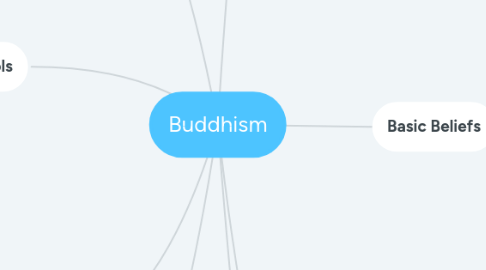
1. Practices
1.1. Puja
1.1.1. Honouring holy beings
1.2. Flowers, incense stick used in rituals
1.3. Meditation
1.3.1. Lotus posture
1.4. Karma
1.4.1. The action of your past life affect your current life/enlightenment
1.5. Chanting Mantras
1.5.1. Symbolic phrases chanted to enhance meditation
2. Symbols
2.1. Lotus Flower
2.1.1. Buddhist vision of human race
2.2. Buddhapada
2.2.1. Representations of Buddha's foot prints
2.3. Mudras
2.3.1. Hand gestures used for meditation
2.4. Wheel of life
2.4.1. Represents the cycle of rebirths as well as enlightenment
2.5. Stupa
2.5.1. Dome shaped holy building housing relics of Buddha or other holy figures
2.6. Mandalas
2.6.1. Visual aid and device for meditation
2.6.2. Very beautiful
2.6.3. often made from coloured sand then destroyed to represent impermanence
3. Festivals
3.1. Visakha Puja day (Buddha day)
3.2. Asalha Puja day (Dharma day)
3.3. Magha Puja day (Sangha day)
3.4. Songkran
3.5. Loy Krathong
4. Sacred Writings
4.1. Tripitaka
4.1.1. Written on palm leaves in 3 baskets
4.1.2. Basket of dicipline
4.1.3. Basket of discourses
4.1.4. Basket of further teachings
4.2. Karma Sutra
4.2.1. Following for eternal happines
5. Origins
5.1. Siddhartha Gautama, "The Buddha"
5.1.1. Born in 553 BCE
5.1.2. "founder"/first teacher of Buddhism
5.1.3. Born into royalty.
5.1.3.1. Predicted by a holy man to be a great spiritual leader
5.1.4. Miraculous birth
5.1.4.1. Born to a virgin mother
5.1.4.2. Descended from heaven in the form of a baby white elephant
5.2. The Four Sights
5.2.1. The old man
5.2.2. The sick man
5.2.3. A dead corpse
5.2.4. An Ascetic
5.2.5. These sights showed Siddhartha that there was suffering, after being sheltered for his whole life
6. Basic Beliefs
6.1. Ultimate goal to end suffering
6.2. Women are considered equal in Buddhism and can also reach enlightenment
6.3. Three characteristics of existence
6.3.1. Anicca
6.3.1.1. Impermanence
6.3.2. Dukkha
6.3.2.1. Life is suffering
6.3.3. Anatta
6.3.3.1. No self
6.4. Five Precepts
6.4.1. No killing or harming living beings
6.4.2. No Stealing
6.4.3. No improper sexual conduct
6.4.4. No false speech/lies
6.4.5. No alcohol or harmful drugs
6.5. Four noble truths
6.5.1. Truth of suffering
6.5.1.1. To live is to suffer
6.5.2. Truth of origin of suffering
6.5.2.1. Negative desire
6.5.3. Truth of extinction of suffering
6.5.3.1. Goal of Buddhism is to end suffering
6.5.4. Truth of the path leading to extinction of suffering
6.5.4.1. Eightfold path
6.5.4.1.1. Right view
6.5.4.1.2. Right intention
6.5.4.1.3. Right speech
6.5.4.1.4. Right action
6.5.4.1.5. Right Livelihood
6.5.4.1.6. Right Effort
6.5.4.1.7. Right concentration
6.5.4.1.8. Right mindfulness
7. Milestones
7.1. Marriage
7.1.1. going to monk to get blessing
7.2. Death
7.2.1. Cremation
7.2.2. Chants/mantras
8. Groups/insitutions
8.1. Theravada
8.1.1. Conservative sect
8.1.2. Dominant in Sri Lanka, Myanmar, Thailand, Cambodia, Laos
8.1.3. Belief of many Buddhas
8.1.4. Ideal Buddhist is a detached, begging monk
8.2. Mahayana
8.2.1. Buddha was more than human
8.2.2. Eternal Buddha
8.2.3. Present in China, Korea, Tibet and some Indonesian islands
8.2.4. Most popular and wide-spread
8.3. Tibetan Buddhism
8.3.1. Belief in magical phrases to achieve goals
8.3.2. Worship Bodhisattva Avalokiteshvara, the patron of the Tibetan people
8.3.3. Dalai Lama
8.3.3.1. Spiritual leader of Tibetan Buddhism
8.3.3.2. Former ruling leader of Tibet

